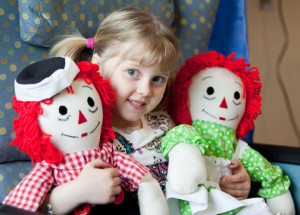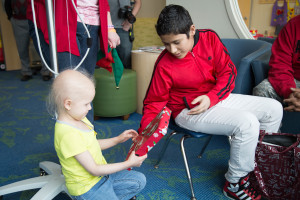Living as a Childhood Neuroblastoma Survivor
 Treatment for neuroblastoma can be long, difficult, and traumatic, not only for the patient but also for friends and family. Once treatment has ended and your child has been declared “cancer free”, it is very common for everyone—patient and family alike—to look forward to returning to “normal life.” And for the most part, it is possible to get back to a life that doesn’t revolve around childhood cancer. At the same time, however, it is important to recognize that childhood cancer has both short- and long-term consequences—both physical and emotional—that can continue to impact your child’s return to cancer-free normalcy.
Treatment for neuroblastoma can be long, difficult, and traumatic, not only for the patient but also for friends and family. Once treatment has ended and your child has been declared “cancer free”, it is very common for everyone—patient and family alike—to look forward to returning to “normal life.” And for the most part, it is possible to get back to a life that doesn’t revolve around childhood cancer. At the same time, however, it is important to recognize that childhood cancer has both short- and long-term consequences—both physical and emotional—that can continue to impact your child’s return to cancer-free normalcy.
Experts agree that the first step in facing life as a neuroblastoma survivor is working with your child’s oncology team to develop a comprehensive survivorship care plan. Such a plan can act as a checklist to help you ensure your child’s short- and long-term health, both physical and emotional, as well as smooth the transition back into a normal cancer-free life. Although the basic outline of any survivorship care plan is fairly standard, your child’s specific plan will be unique to him or her, depending on the characteristics of your child’s cancer and its treatment, as well as your child’s general health.
Your Child’s Survivorship Care Plan
Follow-up exams and tests
One of the most common concerns among parents and families of childhood cancer survivors is, will the cancer return? As of right now, scientists do not believe that there are any steps a parent or child can do after treatment has concluded to reduce the potential for recurrence. Parents can, however, develop—and then stick to—a scheduled plan of follow-up tests and scans. Depending on your child’s risk grouping, size and location of the original tumor, and other factors, tests will probably include both lab work and imaging tests such as PET scans, CT scans, and/or MRIs. As time goes on without recurrence, the time between tests will increase, and eventually the focus may switch to early detection screenings that focus on long-term health effects and/or secondary cancers.
Maintain complete and accurate medical records
As your child begins life as a childhood cancer survivor, it is important to remember that neuroblastoma will impact your child’s life for years to come. Therefore, it is critical to maintain accurate and complete medical records of your child’s entire cancer journey, from first diagnosis through treatment and including post-treatment screenings. Should your child experience health concerns later in life, future physicians will need to know this part of your child’s medical history in detail in order to develop a correct and comprehensive treatment plan.
Possible short- and long-term health effects of neuroblastoma and its treatment
Neuroblastoma and its treatment can, unfortunately, have long-term health effects, often called “late effects.” These may stem from the cancer itself, or from the treatment required to fight the neuroblastoma. Some late effects may present during or immediately after treatment; some may not begin until years later. Some of the most common late effects of neuroblastoma include:
- Hearing loss
- Bone and/or musculature problems (such as scoliosis)
- Thyroid problems
- Growth and development concerns
- Fertility problems
- Neurological concerns
- Secondary cancers
- Opsoclonus myoclonus syndrome (a very rare syndrome in which the body’s immune system begins to attack normal nerve tissue, causing learning disabilities, delayed muscle development, language delays, and behavioral problems)
- Problems with the eyes or with muscle twitches (common in children with tumors located in the neck or chest, may require further treatment with corticosteroids or IVIG)
Emotional and social concerns
In the eagerness to return to “normalcy”, it can be all-too-easy to overlook the emotional stress that childhood cancer puts on both the child and his or her family, emotional stress that can continue to linger once treatment is complete. For older children, returning to school and social activities can prove more challenging than many families anticipate. Many cancer treatment centers can provide access to social workers and counsellors who can help families recognize and cope with the emotional strain of childhood cancer and its treatment.
More about Childhood Neuroblastoma Cancers:
- About Childhood Neuroblastoma Cancer – Detection and Diagnosis
- Causes, Risk Factors, and Prevention of Childhood Neuroblastoma Cancer
- What are the signs and symptoms of Childhood Neuroblastoma Cancer?
- Childhood Neuroblastoma Cancer Treatment
- Childhood Neuroblastoma Cancer – Stages and Prognosis
- What is the expected life span of Childhood Neuroblastoma Cancer?
- After Treatment – Living as a Childhood Neuroblastoma Cancer Survivor
Learn More About the Different Types of Childhood Cancers:
- Childhood Brain Tumor Cancer (Brain Stem Tumors)
- Spinal Cord Tumor Cancer
- Childhood Neuroblastoma Cancers
- Childhood Hodgkin Lymphoma Cancers
- Non-Hodgkin Lymphoma Cancers
- Wilms tumor (Kidney Tumors)
- Rhabdomyosarcoma
- Retinoblastoma
- Bone cancer (including osteosarcoma and Ewing sarcoma)
- Leukemia Cancers: Acute lymphocytic (lymphoblastic) leukemia (ALL) Acute myelogenous leukemia (AML); Juvenile myelomonocytic leukemia (JMML)
- Hepatoblastoma (Liver Cancer)
- Rhabdoid Tumors
About American Childhood Cancer Organization
American Childhood Cancer Organization (ACCO) is a non-profit charity dedicated to helping kids with cancer and their families navigate the difficult journey from cancer diagnosis through survivorship. Internationally, ACCO is the sole U.S. member of Childhood Cancer International (CCI), the largest patient-support organization for childhood cancer in the world. Here in the United States, ACCO promotes the critical importance of ensuring continued funding into new and better treatment protocols for childhood cancer. And most importantly, ACCO is focused on the children: developing and providing educational tools for children fighting cancer and their families, empowering them in their understanding of childhood cancer and the medical decisions they must make during this difficult journey. All of ACCO’s resources are available free of charge for families coping with childhood cancer.
For additional information about childhood cancer or on the ACCO, or to order resources for you or your child, please visit our website at www.acco.org , call 855.858.2226 or visit:



 Nearly one-third of all children and teens with cancer are diagnosed with childhood leukemia, making this form of childhood cancer by far the most common. Childhood leukemia is a cancer of the blood. It begins in the bone marrow, the soft interior of the bones responsible for the development of new blood cells. Leukemia cells in the bone marrow replicate more quickly than healthy cells, and do not die at the proper time, and eventually begin to crowd out healthy cells. As this happens, the cancerous cells enter the blood stream and quickly move around the body. As the leukemia cells invade other organs, they begin to impact the ability of those organs to function normally.
Nearly one-third of all children and teens with cancer are diagnosed with childhood leukemia, making this form of childhood cancer by far the most common. Childhood leukemia is a cancer of the blood. It begins in the bone marrow, the soft interior of the bones responsible for the development of new blood cells. Leukemia cells in the bone marrow replicate more quickly than healthy cells, and do not die at the proper time, and eventually begin to crowd out healthy cells. As this happens, the cancerous cells enter the blood stream and quickly move around the body. As the leukemia cells invade other organs, they begin to impact the ability of those organs to function normally.